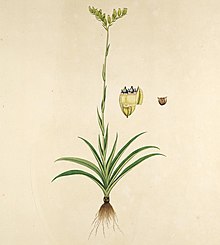Burmannia (plant)
| Burmannia | |
|---|---|

| |
| Burmannia disticha | |
| Scientific classification | |
| Kingdom: | Plantae |
| Clade: | Tracheophytes |
| Clade: | Angiosperms |
| Clade: | Monocots |
| Order: | Dioscoreales |
| Family: | Burmanniaceae |
| Genus: | Burmannia L. |
| Type species | |
| Burmannia disticha | |
| Species | |
| Synonyms[1] | |
| |
Burmannia is a genus of flowering plants long thought of as related to orchids, although more recent studies suggest closer affinities with either the Dioscoreales or the Melanthiales.[3][4][5] The plants are herbs, partially autotrophic (photosynthetic) but also partially parasitic on soil fungi.
Burmannia is native to tropical and subtropical parts of Africa, eastern Asia, Australia, and the Western Hemisphere. Three are regarded as native to the US:[1][6][7][8][9]
The name Burmannia is a taxonomic patronym honoring the Dutch botanist Johannes Burman (1706 - 1779).[2]
Systematics[]
Burmannia comprises the following species.[1]
- - Brazil, Paraguay
- - S Brazil
- - Brazil, Paraguay, Bolivia
- - Sumatra
- - Cuba, N South America
- - Java
- Burmannia biflora - Virginia to Texas; Cuba
- - India, Assam, Bangladesh
- - Thailand, Myanmar, Sumatra
- Burmannia capitata - North Carolina to Texas, West Indies, S Mexico, C + S America
- - S + E + SE Asia, New Guinea
- - E India, Indochina, China, Ryukyu Is
- - Vietnam
- Burmannia coelestis - S + E + SE Asia, New Guinea, N Australia, Micronesia
- - S Venezuela
- - Sumatra
- - E Asia
- - C + SE Brazil
- - Colombia, Venezuela
- Burmannia disticha - S + E + SE Asia, New Guinea, N Australia
- - Enggano I in W Indonesia
- - Guangdong in China
- - S Florida, Chiapas, Cuba, C + S America
- - S Venezuela
- - W New Guinea
- - S Thailand, W Malaysia
- Burmannia grandiflora - Colombia, C Brazil
- - Cameroon, Gabon
- - S India
- - China, Japan
- - Mato Grosso, Goiás
- - N Australia
- - C America, NW S America
- - Thailand
- - tropical Africa
- - New Guinea, Palau
- - Phu-quoc I. in Cambodia; Vietnam
- - Malaysia, Indonesia, Papuasia
- - Madagascar, Mauritius, C + S Africa
- - S Thailand, SE Kalimantan
- - New Guinea
- - Himalayas, E + SE Asia
- - Hainan, Indochina, N Sumatra
- - S. Venezuela, NW Brazil
- Burmannia pusilla - India, Sri Lanka, Vietnam, Cambodia
- - S Venezuela
- - W Malaysia, Sumatra, W Borneo
- - Java
- - S India
- - N Peru
- - Cambodia, Laos, Vietnam
- - N + C South America
- - Goiás, São Paulo
- - Central African Rep
- - Colombia
- - China, India, Indochina
Notes[]
- ^ Maburnia is an imperfect taxonomic anagram of Burmannia.[2]
References[]
- ^ a b c "World Checklist of Selected Plant Families: Royal Botanic Gardens, Kew". apps.kew.org. Retrieved 2017-01-14.
- ^ a b Burkhardt, Lotte (2018-06-06). Verzeichnis eponymischer Pflanzennamen - Erweiterte Edition. Index of Eponymic Plant Names - Extended Edition. Index de Noms éponymiques des Plantes - Édition augmentée (in German). Botanic Garden and Botanical Museum Berlin, Freie Universität Berlin. p. B118. doi:10.3372/epolist2018. ISBN 978-3-946292-26-5.
- ^ Jonker, F. P. 1938. A monograph of the Burmanniaceae. Mededeelingen van het Botanisch Museum en Herbarium van de Rijks Universiteit te Utrecht 51: 1–279.
- ^ Leake, J. R. 1994. Tansley review no. 69. The biology of myco-heterotrophic (‘saprophytic’) plants. New Phytologist 127: 171–216.
- ^ Wood, C. E. Jr. 1983. The genera of Burmanniaceae in the southeastern United States. Journal of the Arnold Arboretum of Harvard University 64: 293–307.
- ^ "Burmannia in Flora of North America @ efloras.org". www.efloras.org. Retrieved 2017-01-14.
- ^ "2013 BONAP North American Plant Atlas. TaxonMaps". bonap.net. Retrieved 2017-01-14.
- ^ "Burmannia in Flora of China @ efloras.org". www.efloras.org. Retrieved 2017-01-14.
- ^ Govaerts, R., Wilkin, P. & Saunders, R.M.K. (2007). World Checklist of Dioscoreales. Yams and their allies: 1-65. The Board of Trustees of the Royal Botanic Gardens, Kew.
| Wikimedia Commons has media related to Burmannia. |
| Wikispecies has information related to Burmannia (Burmanniaceae). |
Categories:
- Burmanniaceae
- Dioscoreales genera